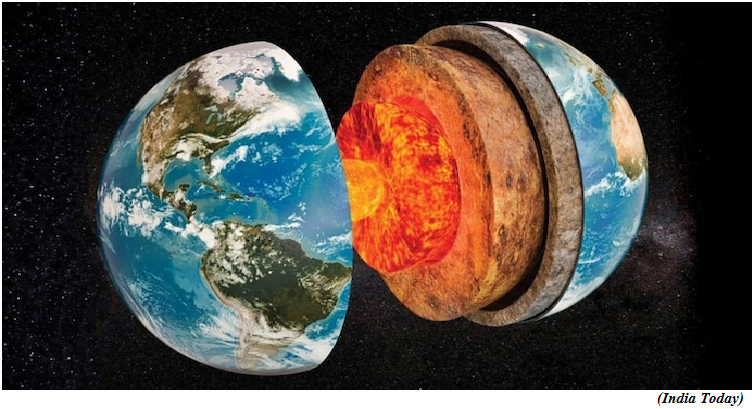India remains a bright spot to contribute 15% of global growth in 2023 IMF (GS Paper 3, Economy)

Why in news?
- India continues to remain a relative “bright spot” in the world economy, and will alone contribute 15% of the global growth in 2023, International Monetary Fund (IMF) said.
Projections:
- For 2023, India is expected to retain a high growth rate, 6.8% for the year that ends in March. For FY 2023/24, (April 2023 to March 2024) IMP project 6.1%, a bit of slowdown like the rest of the world economy, but way above the global average.
- And in that way, India is providing about 15% of global growth in 2023.That is the fastest growth rate among major economies.
Why is India a bright spot?
- India remains a bright spot at a time when the IMF is projecting 2023 to be difficult with global growth slowing down from 3.4% last year to 2.9% in 2023.
- It has done really well to turn the digitalisation that has been already moving quite well into a major driver of overcoming the impact of the pandemic and creating opportunities for growth and jobs.
- India’s fiscal policy has been responsive to economic conditions. The new Budget signals the commitment to fiscal consolidation, while at the same time provides significant financing for capital investments.
- India didn’t shy away to learn the lessons from the pandemic and to implement very strong policies to overcome what has been really a difficult time for a number of months.
Way Forward:
- India is paying attention on investing in the green economy, including renewables with potential to shift the country towards clean energy and keep growth going.
- While digitisation pulled out the world’s fifth-largest economy from pandemic lows, prudent fiscal policy and significant financing for capital investments provided in the Union Budget will help sustain the growth momentum.
The significance of the findings in Keeladi
(GS Paper 1, Culture)
Why in news?
- Keeladi is a tiny hamlet in the Sivaganga district in south Tamil Nadu. It is about 12 km south-east to the temple city of Madurai and is located along the Vaigai river.
- The excavations here from 2015 prove that an urban civilisation existed in Tamil Nadu in the Sangam age on the banks of the Vaigai river.

How is Keeladi linked to Sangam age?
- The Sangam age is a period of history in ancient Tamil Nadu which was believed to be from the third century BCE to the third century CE. The name is derived from the renowned Sangam poets of Madurai from that time.
- Excavations by the Archaeological Survey of India (ASI) and Tamil Nadu State Archaeology Department (TNSDA) has pushed the Sangam age further back.
- In 2019, a TNSDA report dated the unearthed artefacts from Keeladi to a period between sixth century BCE and first century BCE.
- One of the six samples collected at a depth of 353 cm, sent for carbon dating in the U.S., dated back to 580 BCE. The findings in the TNSDA report placed Keeladi artefacts about 300 years earlier than the previously believed third century BCE.
Recent findings:
Are there links to Indus Valley?
- The unearthed Keeladi artefacts have led academics to describe the site as part of the Vaigai Valley Civilisation. The findings have also invited comparisons with the Indus Valley Civilisation while acknowledging the cultural gap of 1,000 years between the two places.
- Till now, the gap is filled with Iron Age material in south India, which serve as residual links. However, some of the symbols found in pot sherds of Keeladi bear a close resemblance to Indus Valley signs. A lot of digging and study has to be done to establish the links between these two civilisations.
- TNSDA affirms that Keeladi has all the characteristics of an urban civilisation, with brick structures, luxury items and proof of internal and external trade.
- It comes across as an industrious and advanced civilisation and has given evidence of urban life and settlements in Tamil Nadu during the Early Historic Period. Keeladi has also added to the credibility of Sangam Literature.
What has been unearthed so far?
- In the eight rounds of excavations, including the first three by the ASI, over 18,000 artefacts have been unearthed from the site and the unique artefacts will be on display at the museum to be opened soon.
- Unearthing of heaps of pottery suggest the existence of a pottery making industry, mostly made of locally available raw materials. Over 120 potsherds containing Tamil Brahmi inscriptions have been found. Keeladi, along with other Tamil Nadu sites which have over a thousand inscribed potsherds, clearly suggest the long survival of the script.
- Spindle whorls, copper needles, terracotta seal, hanging stones of the yarn, terracotta spheres and earthen vessels to hold liquid suggest various stages of a weaving industry. There also existed a dyeing industry and a glass bead industry.
- Gold ornaments, copper articles, semi-precious stones, shell bangles, ivory bangles and ivory combs reflect the artistic, culturally rich and prosperous lifestyle of the Keeladi people.
- Agate and carnelian beads suggest import through commercial networks while terracotta and ivory dice, gamesmen and evidence of hopscotch have been unearthed revealing their pastime hobbies.
Why have French troops withdrawn from Burkina Faso?
(GS Paper 2, International Relation)
Why in news?

Why is France withdrawing?
- For France, the military governments in West Africa pose multiple challenges. In February 2022, while announcing the withdrawal of France and its allies from Mali, French President said, “Victory against terror is not possible if it’s not supported by the state itself.”
- France has also been critical of Russian inroads into Africa. It has accused the Russian private military company Wagner Group for working closely with the military governments in West Africa.
Why did Burkina Faso end it?
Is there Russian involvement?
- Russia’s engagements in Africa have been under scrutiny for a few years, especially after the resurgence of military governments in West Africa since 2020.
- Following Ouagadougou’s announcement of the termination of France operations, Burkinabe Prime Minister Apollinaire Kyelem de Tambela termed Russia “a reasonable choice”.
- Simultaneously, Russia has been courting African countries; in 2023 alone, Russian Foreign Minister Sergei Lavrov visited seven countries in Africa: Angola, Eswatini, South Africa, Eritrea, Mali, Sudan and Mauritania.
What next for France and Burkina Faso?
- France has accepted the military governments’ decision which marks a significant change in its West Africa approach.
- In Burkina Faso, in the absence of France’s troops, the alleged Russian mercenaries may fill the security void, as part of its bid to enhance military engagements in the continent.
- However, the new developments are unlikely to address the insurgency and the consequent insecurity.
Scientists discover fifth layer of Earth
(GS Paper 3, Science and Tech)
Why in news?
Researchers trying to uncover the secrets of Earth's geology have revealed the fifth layer of the planet.

Background:
- Seismic waves generated by earthquakes have revealed new insights about the deepest parts of Earth’s inner core.
- The team of researchers from the Australian National University measured the speeds at which these seismic waves penetrate and pass through the Earth’s inner core.
- They believes that this has presented evidence of a distinct layer inside Earth known as the innermost inner core.
Key Highlights:
- The researchers analysed data from about 200 magnitude-6 and above earthquakes from the last decade.
- This layer is a solid ‘metallic ball’ that sits within the center of the inner core.
- So far, four layers of Earth's structure had been identified. This includes - the crust, mantle, outer core, and inner core. The new findings indicate a fifth layer beneath that.
- The team assessed the seismic waves that travel directly through the Earth’s center and ‘spit out’ at the opposite side of the globe to where the earthquake was triggered. The waves then travel back to the source of the quake.
- The team studied the earthquake, which originated in Alaska. The waves bounced off somewhere in the South Atlantic Ocean, before traveling back to Alaska.
Anisotropy:
- The researchers studied the anisotropy of the iron-nickel alloy that comprises the inside of the Earth’s inner core.
- Anisotropy is used to describe how seismic waves speed up or slow down through the material of the Earth’s inner core, depending on the direction in which they travel.
- They found that bouncing seismic waves repeatedly probed spots near the Earth’s center from different angles.
Observations:
- Theyanalysed the variation of travel times of seismic waves for different earthquakes.
- They found that crystallised structure within the inner core’s innermost region is likely different from the outer layer.
- They suspects that there could have been a major global event at some point during Earth’s evolutionary timeline that led to a “significant” change in the crystal structure of the inner core.
Significance:
- The study states that probing the Earth’s center is critical for understanding planetary formation and evolution.





